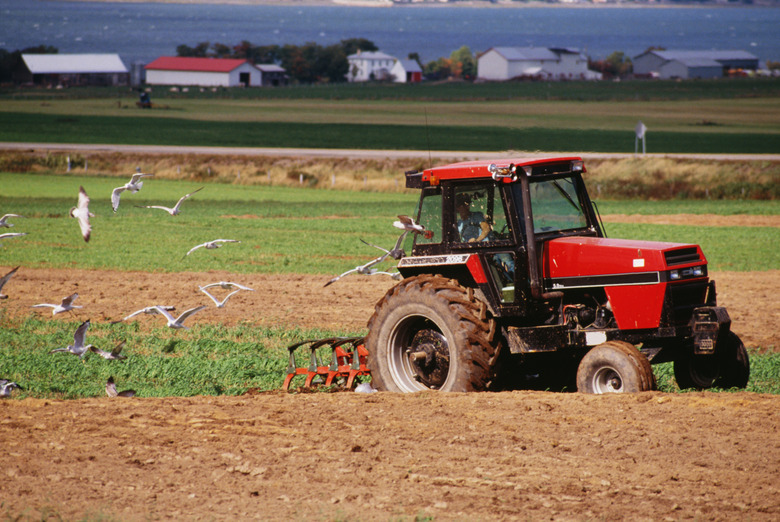Tractor 574 International Specifications
International Harvester manufactured the 574 model agricultural tractor in Doncaster, England, between the years 1970 and 1978. The last International Harvester model, manufactured in 1978, had a $10,000 price tag.
Engine Specs
Engine Specs
International Harvester's 574-model agricultural tractor was fitted with either one of two available engines. One engine runs on regular gasoline while the other was designed to run on diesel fuel. The gas-powered engine is an International Harvester model-C200 engine. This engine features a 3.81-inch by 4.39-inch bore and stroke and a 200.3 cubic-inch piston displacement. The C200 engine is a four-cylinder, liquid-cooled engine with a natural aspiration. The compression ratio on this engine is 7.33:1. The diesel-fueled engine is an International Harvester model-D239 engine. This engine features a 3.87-inch by 5.06-inch bore and stroke and a 238.6 cubic-inch displacement. International Harvester's D239 liquid-cooled engine offers four cylinders and a natural aspiration. The compression ratio on the D239 engine is 12:1.
Weights & Dimensions
Weights & Dimensions
Models of the International Harvester 574 tractor fitted with the C200 gas engine weigh 4,835 pounds while the International Harvester 574 tractors fitted with the D239 engine weigh a total of 5,150 pounds. Regardless of which engine they are designed with, all models of 574 agricultural tractors are 135 inches long and 91 inches tall with an 85.4-inch wheelbase. This tractor employs 14.9-28 rear agricultural tires and 6.50-16.0 front agricultural tires.
Performance
Performance
The gas-powered 574 tractors offer different performance levels than the diesel-powered tractors. Testing found that the gas 574s offer 52.97 horsepower. These models used fuel at a rate of around 4.7 gallons per hour. They also produced 44.03 horsepower of drawbar power and are capable of pulling a maximum 6,360-pound load. Testing found that the diesel models of International Harvester's 574 tractor produce 52.55 horsepower outputs and 45.85 horsepower drawbar power. Max drawbar pull presented by this engine is 6,446 pounds. These engines burn up fuel at a rate of 3.6 gallons per hour.
Other Specs
Other Specs
These models of agricultural tractor are fitted with a fuel tank that offers a 20.34-gallon fuel capacity. International Harvester's 574 features a synchromesh transmission that offers eight forward and four reverse gears. The hydraulic system on this tractor is designed to pump hydraulic fluid at an 11.9 gallon-per-minute rate. These tractors are fitted with hydraulic wet disc brakes.
References
Cite This Article
MLA
Leone, Jay. "Tractor 574 International Specifications" sciencing.com, https://www.sciencing.com/tractor-574-international-specifications-7529170/. 24 April 2017.
APA
Leone, Jay. (2017, April 24). Tractor 574 International Specifications. sciencing.com. Retrieved from https://www.sciencing.com/tractor-574-international-specifications-7529170/
Chicago
Leone, Jay. Tractor 574 International Specifications last modified March 24, 2022. https://www.sciencing.com/tractor-574-international-specifications-7529170/
